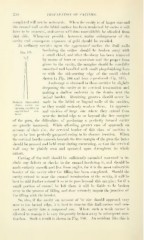Page 232 - My FlipBook
P. 232
230 PliEPAEATIOX OF CAVITIES.
completed will not he noticeable. When the cavity is of larger size and
the enamel wall on the labial surface has Ixmmi weakened by caries it will
have to be removed, and access will thus unavoidably be afforded from
that side. Whenever possible, however, undue eularo-enient of the
cavity and consequent exposure of gold should be avoided.
In ordinary cavities upon the approximal surface the frail walls
T^ ,o^ borderino- the orifice should be broken awav with
hm. 185.
. .
a small chisel, and after the decay has been removed
by means of burs or excavators and the proper form
given to the cavity, the margins should l)e carei'ully
smoothed and bevelled with small plug-finisiiing burs
or with the side-cutting edge of the small chisel
shown in Fig. 166 and here reproduced (Fig. 185).
Anchorage is obtained in these cavities by slightly
deepening the cavity at its cervical termination and
making a shallow undercut in the dentin near the
incisal border. Retaining grooves should never be
Delicate three-sided made in the labial or lingual walls of the cavities,
chisel, useful lor would scriously Weaken them. In apijroxi-
^^
openmg cavities on - •' '^ ^
approximal sur- mal cavitics of large size where they extend from
near the incisal edge to or beyond the free margins
of the gum, the difficulties of producing a perfectly formed cavity
are greatly increased. While affording greater ease of approach on
account of their size, the cervical border of this class of cavities is
apt to be less perfectly prepared owning to its obscure location. When
the cervical border extends beneath the free margin of the gum the latter
should be pressed and held away during excavating, so that the cervical
wall may be plainly seen and operated upon throughout its whole
extent.
Cutting of the wall should be sufficiently extended rootward to in-
clude any defects or checks in the enamel bordering it, and should be
made entirely smooth and free from angles, for it is the most vulnerable
border of the cavity after the filling has been completed. Should the
cavity extend to near the enamel terminatic^i at the cervix, it will be
best to still further extend it so as to pass beyond this margin ; for if a
small portion of enamel be left there it will be lial)le to be broken
aAvay in the process of filling and thus seriously impair the junction of
the filling with the border.
So, also, if the cavity on account of its size should approach very
near to the incisal edge, it is best to remove this frail corner and con-
vert the cavity into a compound one. Where such a weak corner is
allowed to remain it is very frequently broken away in subsequent mas-
tication. Such a result is shown in Fig. 186. An accident like this is


